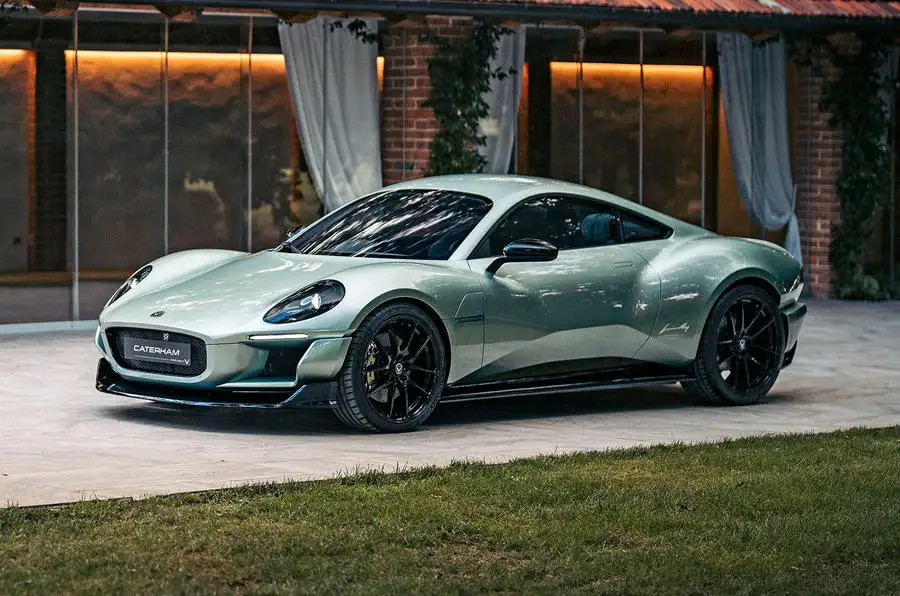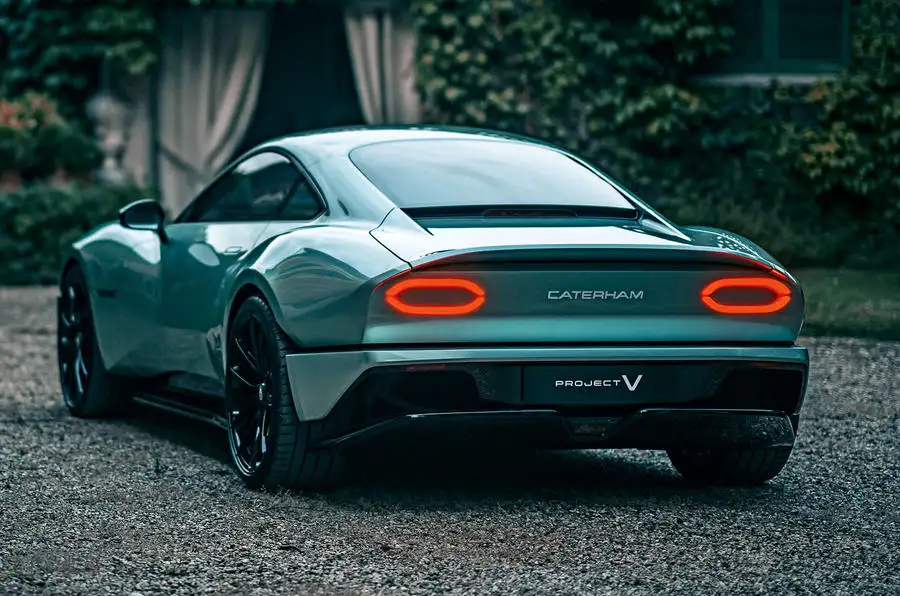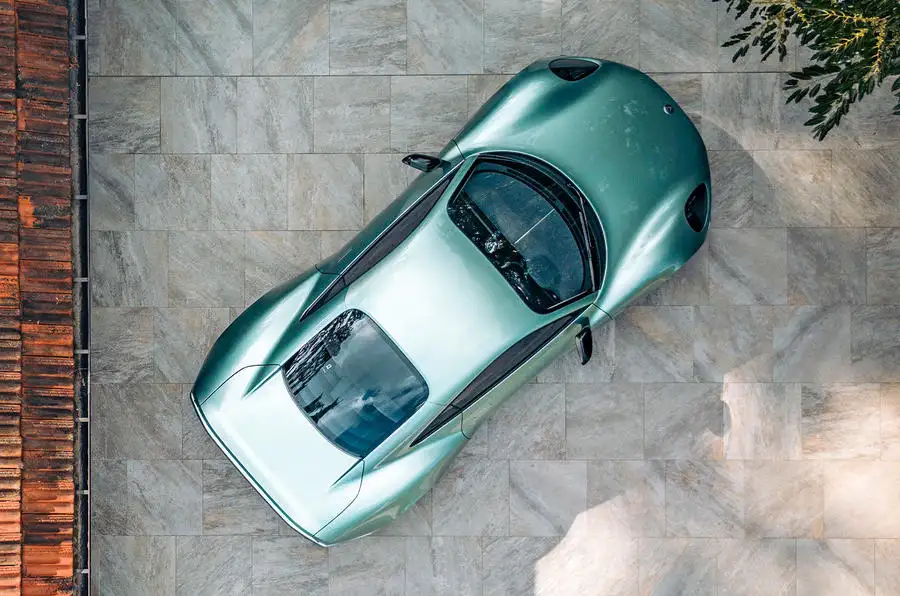Three-seat Project V will weigh 1190kg with electric powertrain.
Caterham headlines the Goodwood Festival of Speed this week with the unveiling of its stunning Project V concept – a vision of an electric sports coupé that the Kent-based marque could put into production as soon as 2026 at a rate of around 2000 units per year.
Completely unrelated to the Caterham Seven and built around a totally bespoke and all-new lightweight architecture, it is described more as a “small tourer” than an apex-hunting track car like its minimalist sibling. It categorically does not replace the Seven, although it has been designed with a rigid focus on the “simple, light and fun to drive” ethos that CEO Bob Laishley says must continue to define the Caterham brand into the electric era.
With a targeted real-world range of 400km, enough luggage space for a weekend away and niceties such as air-con and basic touchscreen infotainment with Apple CarPlay connectivity, it looks to provide everyday utility on a par with cars like the Alpine A110 and Mazda MX-5.
A single permanent magnet synchronous motor delivers 200kW to the rear wheels and is good for a claimed 0-100km/h time of less than 4.5sec and a top speed of 230km/h – figures that point to its billing as a usable sports coupé, rather than a hardcore track toy.
Unusually, the concept features a 2+1 seating layout aimed at bolstering usability compared with two-seat rivals. The single rear seat – “only possible” because of the packaging freedoms afforded by an electric architecture – is designed primarily to carry a child but could conceivably host a shorter adult for brief hops. This is a “very rare” attribute for a purpose-built sports car, said Laishley, and means an owner could feasibly keep the car after having a child, and use the car for more than just solo Sunday morning drives – with the obvious benefit of remaining lighter than a four-seater. However, a fourth seat is planned to be an option for the final car.
On the important subject of kerb weight, Caterham has yet to give a final figure, but Automotive Daily Network partner Autocar understands the concept comes in at about 100kg over the eventual target of 1190kg – less than a Toyota GR86. Composite body panels and “an advanced spaceframe” will be crucial to achieving this final figure, as will lightweight drivetrain components and a suitably sparing equipment list.
The two lithium ion battery packs – combining to give 55kWh of usable capacity and capable of charging at 150kW – are each housed within the 2585mm wheelbase but sited separately under the rear seat and dashboard, respectively, for the optimum balance of weight distribution and interior space. The gap between the two packs allows the front seats to be placed as close to the floor as in a traditional mid-engined sports car and there is room for the rear passenger’s legs behind.
The slim, prismatic battery design needed for this layout does not yet feature in any major OEM’s production car, which is the main reason for the roughly three-year gap between concept and showroom. Caterham has yet to name a supplier for the batteries and other powertrain elements but will source from a third party as it has historically done with engines, switchgear and chassis componentry.
At this early stage, Laishley remains tight-lipped on where the brand will ultimately land on pricing. “Clearly, we’ve got competition. Clearly, we need to position ourselves, but we want people to buy this on an emotional basis and make that transaction,” he said.
“So I don’t want to be drawn on saying the positioning here, there and everywhere. Because whatever I say will be wrong.”
The brand says the car “could be brought to market in 2026 with a target price range starting from less than £80,000”, which implies it will be more directly a rival for the upcoming electric Porsche 718 than the MG Cyberster in terms of outright cost, but details will be given closer to launch.
More important than pricing at this stage, said Laishley, is that the Project V has been designed first and foremost as a production car, rather than a mere showpiece. He said: “A company our size doesn’t have the privilege of making a show model to test the market. We have small assets available to us in terms of finances. We have to spend that financing cleverly and smartly, so we’ve set out from the beginning that this is what we want to make.
“When we move to the production phase, there will be little or no change, certainly to the overall shape. Some things will change: the aero – there has been no aerodynamic study done on this yet – and angles of attack for the spoilers and bits and pieces. We will need to refine some bits and pieces for homologation.
“But essentially, this is our first shot at a production car. It just so happens it’s a model.”
Autocar understands production will be outsourced to a third party, rather than the car being built at Caterham’s new Dartford plant (which is devoted entirely to Seven production), and it could even be produced abroad, with Caterham having identified several “potential candidates” to build the production car. However, Laishley told Autocar “the current candidate is based in the UK”.
He said: “We want to make it in the UK. Obviously, that depends on finding the right partner and potentially getting support from institutions and His Majesty’s government – and we have a plan to do that.”
Notably, Laishley highlighted that although a Caterham is widely regarded as “a British sports car made in the UK”, the brand – owned by Japanese group VT Holdings since 2021 – currently exports more Sevens than it sells in the UK, and it plans to sell the production-spec Project V in the US. “This is a global product,” he said, speaking to Autocar at the Turin headquarters of revered design and engineering outfit Italdesign, where the show car was conceived and built.
Charged with imagining Caterham’s first new road-going model line in nearly three decades was Anthony Jannarelly, best known for the Design-1 sports car – a Nissan V6-powered, rear-driven, two-seat coupé modelled on classic Le Mans prototypes.
His original idea for the Project V centred on creating a modern interpretation of the Lotus Elan – said to be a favourite of VT Holdings chairman and part-time racer Kazuho Takahashi. However, Jannarelly was cautious to avoid overtly retro cues because “we don’t want it to feel old in five years”.
He did, though, point to the Lotus 40 racer he saw at the Goodwood Revival last year as an influence on the Project V’s lithe, minimalist silhouette. He said: “What I like about the Lotus 40 wasn’t really any specific styling cues. It was more about the principle: you have a chassis and you have a skin that really follows as close as possible to the chassis.”
Jannarelly added: “It’s like if you have a soft sheet and you drape it over the chassis.” He highlighted the very visible architectural elements of the Seven as a key factor in its enduring appeal, saying: “With the Seven, it is form follows function. In some forms, I tried to apply almost the same rules, but this time the function is to cover the chassis.”






